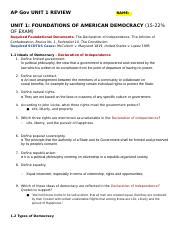Understanding the Framework of the US Government
Every four years, the US holds a presidential election that captivates the nation and the world stage. But beyond the fanfare and political rhetoric lies a complex web of institutions and principles that shape the very fabric of the American government. In AP Government Unit 1, students embark on an in-depth exploration of these foundational concepts, laying the groundwork for a comprehensive understanding of American politics.

Key Concepts to Master:
- Constitution: The supreme law of the land, establishing the structure, powers, and limitations of the federal government.
- Federalism: The division of power between the central (federal) government and state governments.
- Separation of Powers: The principle that divides governmental functions among three branches (legislative, executive, and judicial) to prevent any one branch from becoming too powerful.
- Checks and Balances: Mechanisms designed to prevent any one branch from dominating the other two, ensuring a balance of power.
- Rule of Law: The concept that everyone, including government officials, is subject to the law.
- Civil Liberties: Fundamental rights and freedoms guaranteed to individuals by the Constitution.
Why This Unit Matters:
Unit 1 serves as the cornerstone for understanding the complexities of American government. By delving into the foundational principles, students gain a solid grasp of:
- The origins and evolution of the US Constitution
- The dynamic relationship between federal and state governments
- The delicate balance of power maintained through separation of powers and checks and balances
- The essential role of civil liberties in a free and democratic society
How This Unit Benefits Students:
Mastering the concepts of Unit 1 enables students to:
- Develop critical analytical skills: Analyze political structures, processes, and policies with an informed perspective.
- Understand current events: Contextualize news stories and political debates by connecting them to foundational principles.
- Participate effectively in civic life: Understand their rights and responsibilities as citizens, fostering a sense of civic duty.
Common Mistakes to Avoid:
- Oversimplifying the Constitution: Avoid viewing the Constitution as a static document. It is a living document that has been interpreted and amended over time to reflect changing societal needs.
- Underestimating federalism: Recognize the significant role of state governments in the American political system.
- Confusing separation of powers with checks and balances: Separation of powers divides governmental functions, while checks and balances ensures no one branch has excessive authority.
- Neglecting the importance of civil liberties: Understand that civil liberties are not mere ideals but essential rights that safeguard individual freedoms.
A Step-by-Step Approach to Unit 1:
Step 1: Delve into the Constitution
- Analyze the structure and content of the Constitution, including its key principles and provisions.
- Examine the historical context and motivations behind the creation of the Constitution.
Step 2: Explore Federalism
- Define federalism and explain how it divides power between the federal and state governments.
- Analyze the benefits and challenges of a federal system.
Step 3: Understand Separation of Powers
- Describe the three branches of government and their respective powers.
- Identify the mechanisms that create separation of powers within the government.
Step 4: Examine Checks and Balances
- Explain the concept of checks and balances and how it prevents any one branch from dominating the others.
- Provide examples of how checks and balances are implemented in practice.
Step 5: Emphasize Rule of Law
- Define rule of law and its significance in a democratic society.
- Discuss the historical precedents and legal principles that support the rule of law.
Step 6: Analyze Civil Liberties
- Identify the key civil liberties guaranteed by the Constitution.
- Understand the legal framework and Supreme Court decisions that have shaped the interpretation of civil liberties.
Tabular Summary of Key Concepts:
| Concept | Definition | Importance |
|---|---|---|
| Constitution | Supreme law of the land, establishing the structure and powers of the federal government | Provides the foundation for American government and protects individual rights. |
| Federalism | Division of power between the federal and state governments | Promotes local autonomy and prevents excessive centralization of power. |
| Separation of Powers | Dividing governmental functions among three branches to prevent any one branch from becoming too powerful | Ensures a balance of power and prevents tyranny. |
| Checks and Balances | Mechanisms that prevent any one branch from dominating the other two | Maintains equilibrium within the government and protects against abuse of power. |
| Rule of Law | Everyone, including government officials, is subject to the law | Ensures fairness, equality, and accountability in society. |
| Civil Liberties | Fundamental rights and freedoms guaranteed to individuals by the Constitution | Protect individual autonomy and foster a free and democratic society. |
